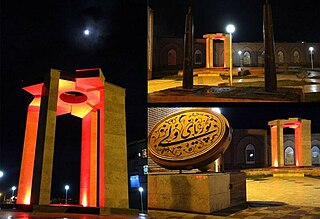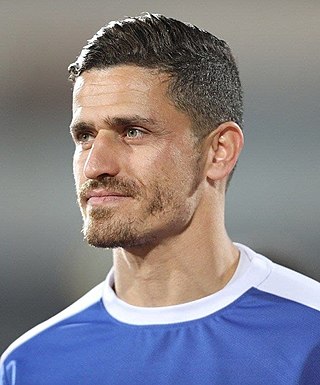
Kabaddi is a contact team sport played between two teams of seven players, originating in ancient India. The objective of the game is for a single player on offence, referred to as a "raider", to run into the opposing team's half of the court, touch out as many of their players as possible, and return to their own half of the court, all without being tackled by the defenders in 30 seconds. Points are scored for each player tagged by the raider, while the opposing team earns a point for stopping the raider. Players are taken out of the game if they are touched or tackled, but return to the game after each point scored by their team from a tag or tackle.

An ace is a playing card, die or domino with a single pip. In the standard French deck, an ace has a single suit symbol located in the middle of the card, sometimes large and decorated, especially in the case of the ace of spades. This embellishment on the ace of spades started when King James VI of Scotland and I of England required an insignia of the printing house to be printed on the ace of spades. This insignia was necessary for identifying the printing house and stamping it as having paid the new stamp tax. Although this requirement was abolished in 1960, the tradition has been kept by many card makers. In other countries the stamp and embellishments are usually found on ace cards; clubs in France, diamonds in Russia, and hearts in Genoa because they have the most blank space.

In playing cards, a suit is one of the categories into which the cards of a deck are divided. Most often, each card bears one of several pips (symbols) showing to which suit it belongs; the suit may alternatively or additionally be indicated by the color printed on the card. The rank for each card is determined by the number of pips on it, except on face cards. Ranking indicates which cards within a suit are better, higher or more valuable than others, whereas there is no order between the suits unless defined in the rules of a specific card game. In a single deck, there is exactly one card of any given rank in any given suit. A deck may include special cards that belong to no suit, often called jokers.

The tombak, tonbak (تنبک) or zarb (ضَرب) is an Iranian goblet drum. It is considered the principal percussion instrument of Persian music. The tombak is normally positioned diagonally across the torso, while the player uses one or more fingers and/or the palm(s) of the hand(s) on the drumhead, often near the drumhead's edge. Sometimes, tombak players wear metal finger rings for an extra-percussive "click" on the drum's shell. Tombak virtuosi often perform solos lasting ten minutes or more.

Many sports in Iran are both traditional and modern. Tehran, for example, was the first city in West Asia to host the Asian Games in 1974, and continues to host and participate in major international sporting events to this day. Freestyle wrestling has been traditionally regarded as Iran's national sport, however today, football is the most popular sport in Iran. Because of economic sanctions, the annual government's budget for sport was about $80 million in 2010 or about $1 per person.

Pahlavān Mahmoud, known in Iran as Pouryā-ye Vali, was a pahlevani wrestling champion, Sufi teacher and poet from the 14th century Persia, famous for his exceptional strength. He became the patron saint of the city of Khiva, in Uzbekistan.
Pasur or chahar barg is a fishing card game of Persian origin. Played widely in Iran, it is played similarly to the Italian games of Cassino or Scopa and even more similarly to the Egyptian game of Bastra. Pasur is also known by the names Chahâr Barg, Haft Khâj or Haft Va Chahâr, Yâzdah.

Ganjifa, Ganjapa or Gânjaphâ, is a card game and type of playing cards that are most associated with Persia and India. After Ganjifa cards fell out of use in Iran before the twentieth century, India became the last country to produce them. The form prevalent in Odisha is Ganjapa.

Pahlevani and zourkhaneh rituals is the name inscribed by UNESCO for varzesh-e pahlavāni or varzesh-e bāstāni, a traditional system of athletics and a form of martial arts originally used to train warriors in Iran (Persia) Outside Iran, zoorkhanehs can now also be found in Azerbaijan, and Afghanistan, and were introduced into Iraq in the mid-19th century by the Iranian immigrants, where they seem to have existed until the 1980s before disappearing. It combines martial arts, calisthenics, strength training and music. It contains elements of pre-Islamic and post-Islamic culture of Iran with the spirituality of Persian Shia Islam and Sufism. Practiced in a domed structure called the zurkhāneh, training sessions consist mainly of ritual gymnastic movements and climax with the core of combat practice, a style of folk wrestling called koshti pahlavāni.
Shelem, also called Rok or similar, is an Iranian trick-taking card game with four players in two partnerships, bidding and competing against each other. Bidding and trump are declared in every hand by the bidding winner. Both the name and the point structure of this game are similar to the American game Rook, there being a possible connection between the two games. Though it isn't clear from which game it is derived.

Association Football is the most popular sport overall in Asia. Cricket is the second most popular sport in Asia, and is most popular in South Asia. Other popular sports in Asia include basketball, baseball, badminton and table tennis among others. There are also some traditional sports that are popular in certain regions of Asia, such as the South Asian sports kabaddi and kho-kho, and sepak takraw in Southeast Asia. Top sporting nations/regions in Asia include China, Japan, South Korea, Taiwan, India, Iran, Kazakhstan and Uzbekistan.

Pahlavan Mirza Hashem Akbarian was an Iranian practitioner of traditional wrestling.

Voria Ghafouri is an Iranian retired footballer. He has played much of his career as a right-back and also played as a right winger occasionally.

Kabaddi, is a contact sport, native to the Indian subcontinent. It is one of the most popular sports in India, played mainly among people in villages. India has taken part in four Asian Games in kabaddi, and won gold in all of them. Four forms of kabaddi played in India are Amar, Suranjeevi, huttuttoo, and Gaminee. Amar is generally played in Punjab, Haryana, the United States, Canada, and other parts of the world, mostly by Punjabi sportsmen. Suranjeevi is the most played form of kabaddi in India and the world. This is the form used in international matches generally and played in Asian Games. Huttuttoo was played by men in Maharashtra. In Gaminee style, seven players play on each side and a player put out has to remain out until all his team members are out. The team that is successful in outing all the players of the opponent's side secures a point. The game continues until five or seven such points are secured and has no fixed time duration.

Chovgan, Chowgan or Chogan, is a sporting team game with horses that originated in ancient Iran. It was considered an aristocratic game and held in a separate field, on specially trained horses. The game was widespread among the Asian peoples. It is played in Iran, Azerbaijan, Tajikistan, and Uzbekistan.

Pahlevan of Iran is a national championship for pahlevani wrestling held annually in Iran. Though the competition has ancient roots, its modern form began in 1944.

Ganjapa are the traditional playing cards from the Indian state Odisha. It can also refer to the trick-taking card game that they are used for. It is played with circular shaped Pattachitra painted cards. Originated in the 16th century, Ganjaku is a recreational game for male members of the Odia society, primarily villagers, kings and their courtmen. Ganjapa is played as "Charirangi", "Atharangi", "Dasarangi", "Bararangi", "Chaudarangi" and "Sohalarangi". The variation of this game influenced by Persian card game Ganjifeh is known as "Mughal Ganjifa". The game is popular in Puri and Ganjam district of Odisha. As a result of the relative isolation of Odisha in the past, Ganjapa developed very differently from the Ganjifa found in the rest of India. Odisha has by far the largest community of Ganjifa players and manufacturers.

As-Nas is a card game or type of playing cards that were used in Persia.

India has several traditional games and sports, some of which have been played for thousands of years. Their popularity has greatly declined in the modern era, with Western sports having overtaken them during the British Raj, and the Indian government now making some efforts to revive them. Many of these games do not require much equipment or playing space. Some of them are only played in certain regions of India, or may be known by different names and played under different rules and regulations in different regions of the country. Many Indian games are also similar to other traditional South Asian games.

Many sports are played in South Asia, with cricket being the most popular of them; 90% of the sport's worldwide fans live in South Asia. Football is followed passionately in some parts of South Asia, such as Kerala and Bengal. Field hockey was popular for several decades, with some of South Asia's greatest sporting accomplishments having taken place in this sport. Some native South Asian games are played professionally in the region, such as kabaddi and kho-kho, and also feature in regional competitions such as the South Asian Games and Asian Games.




















